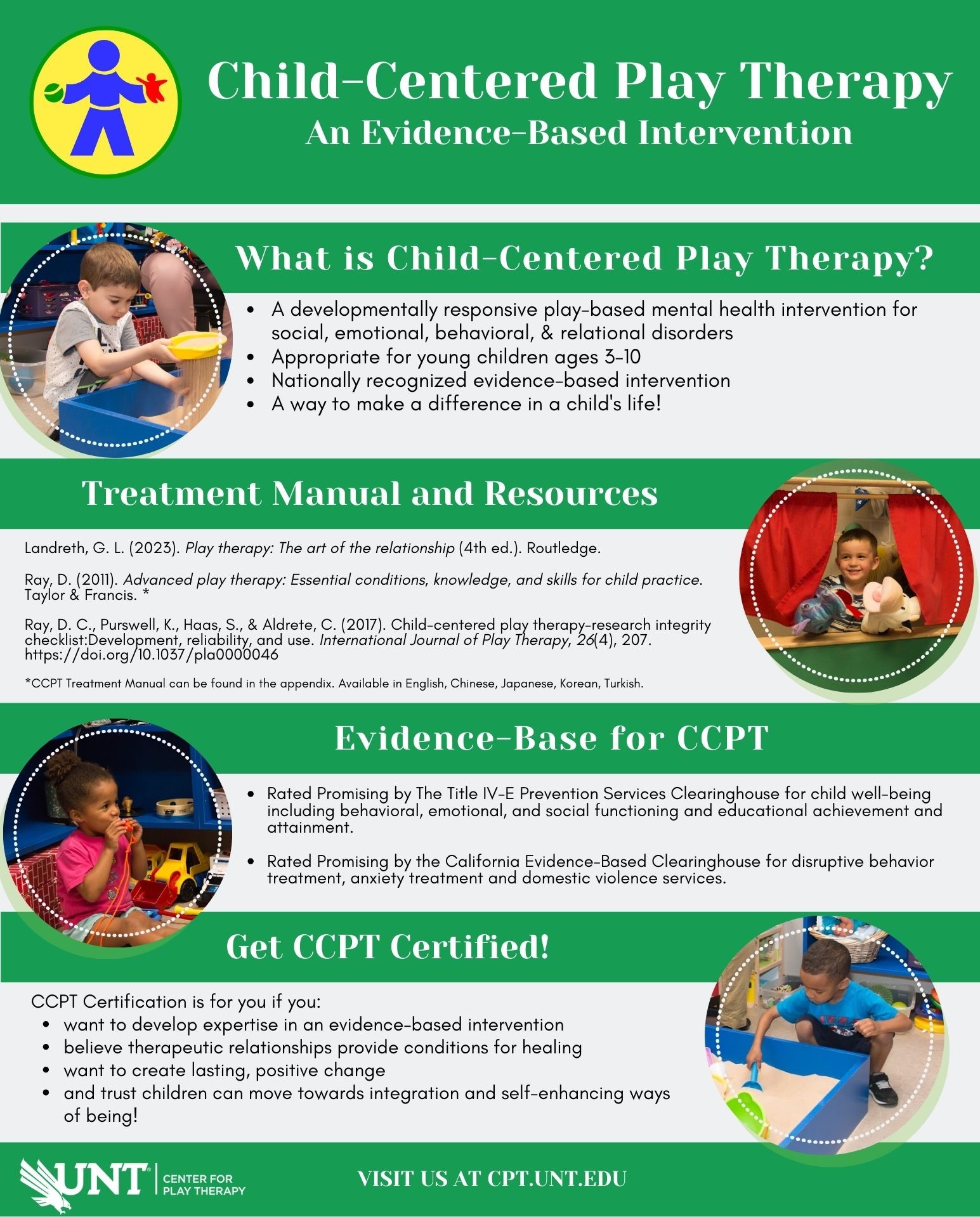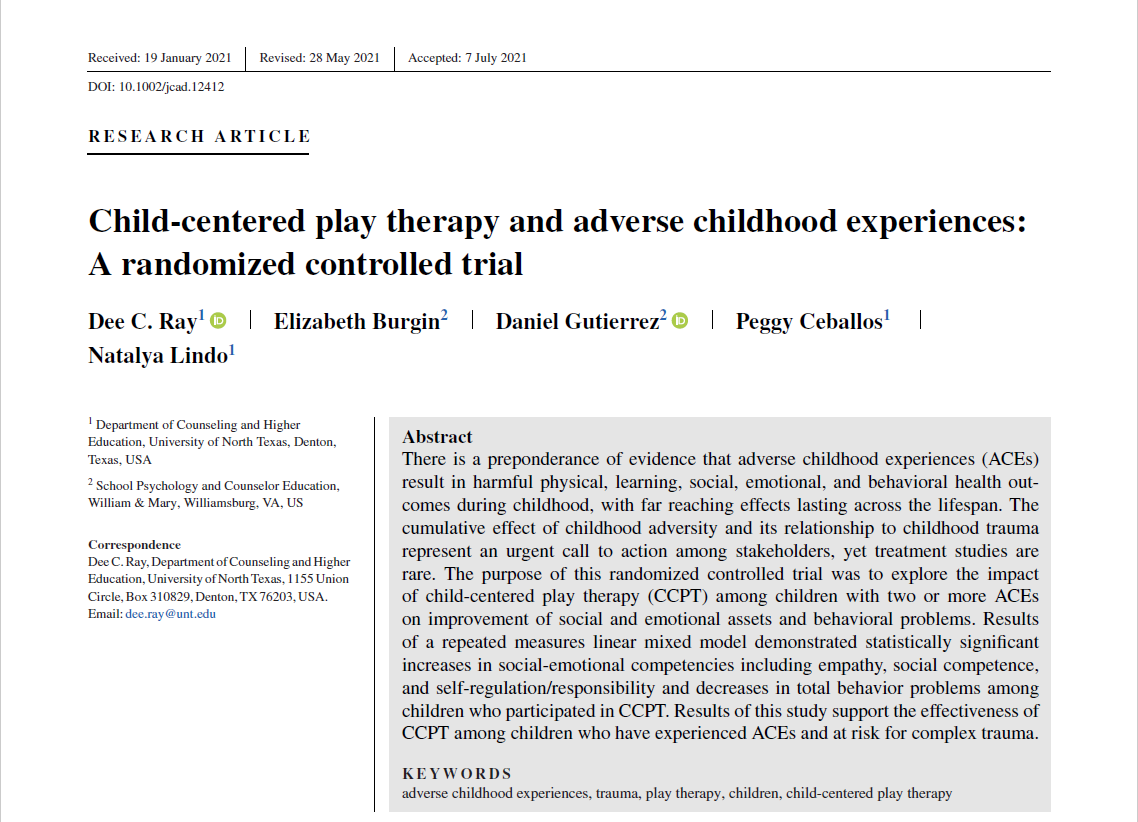
CCPT is a developmentally responsive, play-based mental health intervention for young children ages 3 to 10 who are experiencing social, emotional, behavioral and relational disorders. CCPT utilizes play, the natural language of children, and therapeutic relationship to provide a safe, consistent therapeutic environment in which a child can experience full acceptance, empathy, and understanding from the counselor and process inner experiences and feelings through play and symbols. In CCPT, a child’s experience within the counseling relationship is the factor that is most healing and meaningful in creating lasting, positive change. Based on person-centered principles, the overarching goal of CCPT is to unleash the child’s potential to move toward integration and self-enhancing ways of being. Child outcomes following CCPT include decreased symptomatic behaviors and improvement in overall functioning.
Treatment Manual and Resources
Landreth, G. L. (2023). Play therapy: The art of the relationship (4th. ed.). Routledge.
*** CCPT Treatment Manual available in appendix.
Ray, D. C., Purswell, K., Haas, S., & Aldrete, C. (2017). Child-centered play therapy-research integrity checklist: Development, reliability, and use. International Journal of Play Therapy, 26(4), 207. https://doi.org/10.1037/pla0000046
Available Languages
The CCPT manual is available in English, Chinese, Japanese, Korean, and Turkish.

Child-Centered Play Therapy is designated as a promising evidence-based mental health intervention by The Title IV-E Prevention Services Clearinghouse and the California Evidence-Based Clearinghouse for Child Welfare (CEBC).

Click here to read the full article
Randomized Controlled Trials and Quasi-experimental Studies
(Mental Health Focus)
Blalock, S. M., Lindo, N., & Ray, D. C. (2019). Individual and group child‐centered play therapy: Impact on social‐emotional competencies. Journal of Counseling & Development, 97(3), 238–249. https://doi.org/10.1002/jcad.12264
Bratton, S. C., Ceballos, P.L., Sheely-Moore, A.I., Meany-Walen, K., Pronchenko, Y. & Jones, L.D. (2013). Head start early mental health intervention: Effects of child-centered play therapy on disruptive behaviors. International Journal of Play Therapy 22(1): 28–42. https://doi.org/10.1037/a0030318
Burgin, E. E., & Ray, D. C. (2022). Child-centered play therapy and childhood depression: An effectiveness study in schools. Journal of Child and Family Studies 31, 293-307. https://doi:10.1007/s10826-021-02198-6
Cochran, J. L., & Cochran, N. H. (2017). Effects of child-centered play therapy for students with highly-disruptive behavior in high-poverty schools. International Journal of Play Therapy, 26(2), 59–72. https://doi.org/10.1037/pla0000052
Garza, Y., & Bratton, S. C. (2005). School-Based Child-Centered Play Therapy with Hispanic Children: Outcomes and Cultural Consideration. International Journal of Play Therapy, 14(1), 51–80. https://doi.org/10.1037/h0088896
Kot, S., Landreth, G. L., & Giordano, M. (1998). Intensive child-centered play therapy with child witnesses of domestic violence. International Journal of Play Therapy, 7(2), 17–36. https://doi.org/10.1037/h0089421
Post, P. (1999). Impact of child-centered play therapy on the self-esteem, locus of control, and anxiety of at-risk 4th, 5th, and 6th grade students. International Journal of Play Therapy, 8(2), 1–18. https://doi.org/10.1037/h0089428
Ray, D. C., Blanco, P. J., Sullivan, J. M., & Holliman, R. (2009). An exploratory study of child-centered play therapy with aggressive children. International Journal of Play Therapy, 18(3), 162–175. https://doi.org/10.1037/a0014742
Ray, D. C., Burgin, E., Gutierrez, D., Ceballos, P., & Lindo, N. (2022). Child‐centered play therapy and adverse childhood experiences: A randomized controlled trial. Journal of Counseling & Development, 100(2), 134–145.https://doi:10.1002/jcad.12412
Ray, D. C., Schottelkorb, A., & Tsai, M.-H. (2007). Play therapy with children exhibiting symptoms of attention deficit hyperactivity disorder. International Journal of Play Therapy, 16(2), 95–111. https://doi.org/10.1037/1555-6824.16.2.95
Ray, D. C., Stulmaker, H. L., Lee, K. R., & Silverman, W. K. (2013). Child-centered play therapy and impairment: Exploring relationships and constructs. International Journal of Play Therapy, 22(1), 13–27. https://doi.org/10.1037/a0030403
Ritzi, R. M., Ray, D. C., & Schumann, B. R. (2017). Intensive short-term child-centered play therapy and externalizing behaviors in children. International Journal of Play Therapy, 26(1), 33–46. https://doi.org/10.1037/pla0000035
Taylor, L., & Ray, D. C. (2021). Child-centered play therapy and social–emotional competencies of African American children: A randomized controlled trial. International Journal of Play Therapy, 30(2), 74–85. https://doi:10.1037/pla0000152
Schottelkorb, A. A., Swan, K. L., & Ogawa, Y. (2020). Intensive child‐centered play therapy for children on the autism spectrum: A pilot study. Journal of Counseling & Development, 98(1), 63–73. https://doi.org/10.1002/jcad.12300
Stulmaker, H. L., & Ray, D. C. (2015). Child-centered play therapy with young children who are anxious: A controlled trial. Children and Youth Services Review, 57, 127–133. https://doi.org/10.1016/j.childyouth.2015.08.005
Wilson, B., & Ray, D. (2018). Child‐centered play therapy: Aggression, empathy, and self‐regulation. Journal of Counseling & Development, 96(4): 399–409. https://doi.org/10.1002/jcad.12222
The UNT Center for Play Therapy offers Child-Centered Play Therapy (CCPT) training according to the evidence-based model recognized by The Title IV-E Prevention Services Clearinghouse and California Evidence-Based Clearinghouse for Child Welfare. Training in the evidence-based model of CCPT requires following approved treatment protocols. The UNT Center for Play Therapy advises therapists to consider where they seek CCPT training as some trainings do not teach according to the evidence-based model. For more information on the recognized protocols and training, search Child-Centered Play Therapy at Title IV or CEBC.
Download the Child-Centered Play Therapy: An Evidence-Based Intervention quick facts flyer here.









